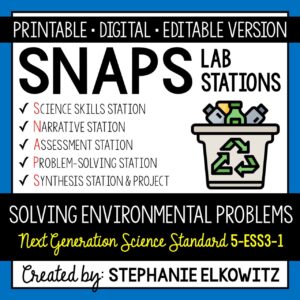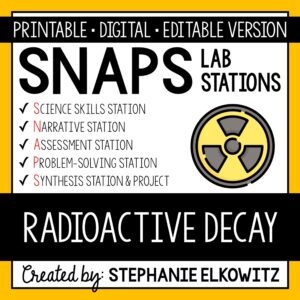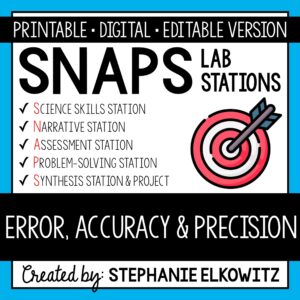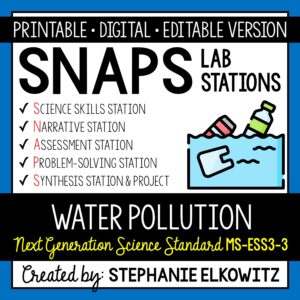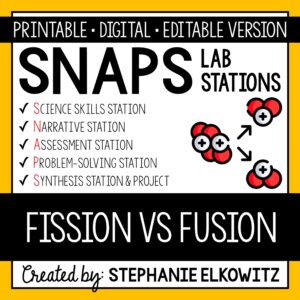MS-ESS1-1 Seasons and Earth’s Tilt Lab
$7.00
An engaging lab activity designed to enhance students’ understanding of Earth’s position and tilt as it revolves around the Sun and changes in the seasons. Aligned with NGSS MS-ESS1-1.
Description
MS-ESS1-1 Seasons and Earth’s Tilt Lab Preview
SNAPs Lab Stations Activities require students to use science, math, literacy, problem-solving and engineering skills. They are designed to enhance students’ understanding of scientific concepts and help students apply scientific ideas to the real world. Each station activity promotes skills so to develop students into proficient and competent scientific thinkers.
SNAPs lab activities have five components:
• Science Skills Station to develop science skill proficiency
• Narrative Station to build science literacy
• Assessment Station to evaluate learning and understanding
• Problem-Solving Station to foster engineering design
• Synthesis Station and Project to inspire higher-order learning
DIGITAL LABORATORY – DISTANCE LEARNING & DIGITAL CLASSROOMS
• This lab is offered in a digital format to support digital classrooms & distance learning.
• The digital lab activity is designed to work with Google Slides and Microsoft PowerPoint
• The digital lab activity CANNOT be edited. However:
– Students can manipulate text boxes
– Students can create tables, graphs and diagrams
– Students can insert images and drawings
GOOGLE FORM ASSESSMENT STATION
• The assessment station is offered as a self-grading Google Form.
• Questions are all short answer and are 100% editable.
• Suggestions for use are included in the download.
DISTANCE LEARNING COMPATIBILITY
SNAPs lab activities are rated for their ease with distance – independent learning. Refer to the preview for more information about how well this laboratory works in a fully digital classroom and with distance learning.
EDITABLE DOCUMENTS
This download includes an editable word document (docx file) of all lab components:
• Pre-Lab and Post-Lab Activities
• The Lab Overview
• Lab Station Activities and Questions
• Directed Synthesis Project (when applicable)
Important Notes:
• Diagrams, illustrations, tables and graphs essential to lab activities are included
• Illustrative clipart is NOT included
• Editable documents and rubrics are included with the FREE SNAPs Setup Guide
Editable files allow you to:
• Edit the scope of the activities so to suit your students’ needs
• Edit the materials required based on resource availability
• Create single-period “mini-labs” using activities at the individual skills stations
The activities at each station in this lab are detailed below.
Seasons and Earth’s Tilt Lab Learning Objectives
1. Recognize Earth’s position as it revolves around the sun.
2. Relate Earth’s tilt and revolution to changes in the seasons.
3. Compare the intensity of direct and indirect sunlight.
4. Illustrate Earth’s position relative to the sun at the summer solstice, winter solstice, spring equinox and fall equinox.
Science Skills Station
Students will complete a graphing activity. Students will graph the solar elevation on the 21st of each month for a location and relate the data to the average monthly temperature of the same location.
Narrative Station
Students will read about Earth’s tilt and how it impacts the way sunlight hits Earth (direct or indirect). Students will also read about the position of Earth relative to the sun as it revolves around Earth. They will read about how Earth’s tilt “changes,” which leads to the change of seasons.
Assessment Station
At this station, students will answer questions about key terms and ideas relating to the Earth’s tilt and the seasons. Students must employ lower, mid and higher order thinking skills to answer these questions.
Problem-Solving Station
At this station, students will construct a three-dimensional model that depicts Earth’s position relative to the sun at the summer solstice, winter solstice, fall equinox and spring equinox. Students will use this model to illustrate the position of Earth relative to the sun.
Synthesis Station
Students will compose a CER (claim-evidence-reasoning) report to summarize the lab. Students are provided the claim statement and must support the claim with observations, data and other information gathered in the lab. Students will explain how the evidence supports the claim using scientific reasoning.
Synthesis Project
Students will have a choice of 11 projects. Refer to the SNAPs Lab Stations Best Practices and Setup Guide for directions and suggestions on how to conduct the project.
This download includes:
• A pre-lab assignment and post-lab reflection
• Directions and questions for each lab station
• Student recording sheets
• Teacher Key
Additional Materials Required:
Ruler
Colored Pencils
Toothpicks
Thin wood dowels or skinny wood sticks
Large styrofoam ball (1 per group)
Small styrofoam balls (4 per group)
Black Sharpie
Markers
NEXT GENERATION SCIENCE STANDARDS
This laboratory satisfies NGSS MS-ESS1-1. It combines the three dimensions of science learning – science and engineering practices, disciplinary core ideas and crosscutting concepts – to meet the standard. This lab also makes interdisciplinary connections to STEM, Math CCSS and ELA CCSS to build the appropriate skills.
TERMS OF USE
• All rights reserved by Stephanie Elkowitz.
• This product is to be used by the original purchaser only.
• Intended for classroom and personal use only.
• Copying for more than one teacher, classroom, department, school, or school system is prohibited.
• This product may not be distributed or displayed digitally for public view.
• Failure to comply is a copyright infringement and a violation of the Digital Millennium Copyright Act (DMCA).




